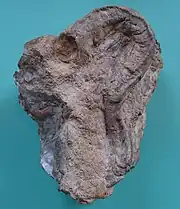| Kuphus Temporal range: Oligocene to Present | |
|---|---|
| Scientific classification | |
| Domain: | Eukaryota |
| Kingdom: | Animalia |
| Phylum: | Mollusca |
| Class: | Bivalvia |
| Order: | Myida |
| Superfamily: | Pholadoidea |
| Family: | Teredinidae |
| Genus: | Kuphus Guettard, 1770[1] |
| Species | |
| |
Kuphus is a genus of shipworms, marine bivalve molluscs in the family Teredinidae. While there are four extinct species in the genus,[2] the only extant species is Kuphus polythalamius (also incorrectly spelled as Kuphus polythalamia).[3][4] It is the longest bivalve mollusc in the world, where the only known permanent natural habitat is Kalamansig, Sultan Kudarat in the Philippines.[5]
Members of this genus secrete calcareous tubes. Based only on the calcareous tube, this species was originally thought by Linnaeus to be a tube worm, so he placed it in the genus Serpula. Despite the fact that Kuphus polythalamius is now known to be a mollusc, its common name is the giant tube worm.[6] Since 1981 however, the name "giant tube worm" has also been applied to the hydrothermal vent species Riftia pachyptila, which is indeed a worm, an annelid.
Species
The sole living species is:
Extinct species are:
- †Kuphus arenarius
- †Kuphus incrassatus
- †Kuphus fistula
- †Kuphus melitensis
Taxonomy
Large, tusk-shaped, calcareous tubes were occasionally washed up on beaches. There was disagreement among zoologists in the 18th century as to whether the creature which made one of these was a polychaete tube-worm or came from a mollusc. Linnaeus described the species in 1758. He considered that it was a serpulid worm and named it Serpula arenaria, a name which in 1767 he changed to Serpula polythalamia. There was some confusion as to precisely which taxon he was describing, but S. polythalamius became the type species of the genus Serpula, a genus of polychaete worms. In 1770, Guettard introduced the name Kuphus for the genus, realising that the animal was not a worm but a mollusc. This meant that, according to the ICZN rules, the specific name became Kuphus polythalamius (Linnaeus, 1758).[7]
Fossil record

Fossils of Kuphus polythalamius have been found dating back to the Oligocene. They came from rocks in various tropical and sub-tropical areas including Indonesia, Pakistan, Jamaica, Grenada, South Africa and Somalia.[8]
Fossils of the extinct species, Kuphus melitensis, are found in Late Oligocene-aged coralline limestone of Malta.[2]
Fossils of the extinct species, Kuphus incrassatus, have been found in rocks in Jamaica, Mexico, Panama, Puerto Rico, Trinidad and Tobago, Florida and Mississippi.[9] Another species is Kuphus arenarius that have been recorded in Oligocene to Miocene-aged limestone layers of Asmari Formation in Iran. They are common in sedimentary Tertiary rocks in the Caribbean region. They date back to the Oligocene and Miocene and have been used for absolute dating of the rocks, using the relative proportions of two strontium isotopes in the fossils.[10]
Fossils of the extinct species, Kuphus fistula, dating from the Miocene and Pliocene, have been found in various locations in Virginia in the United States.[11]
Misidentification as dinosaur remains
Fossils found near Warsaw by paleontologist, Friedrich von Huene in 1941 were misidentified as being the teeth and parts of the jaw of a new species of dinosaur, which he named Succinodon putzeri. It was later determined that these were in fact the fossil remains of a marine boring bivalve, a previously undescribed species of Kuphus.[12]
Distribution
Today, Kuphus polythalamius is found in the western Pacific Ocean, the western and eastern Indian Ocean and the Indo-Malaysian area.[13] The range includes the Philippines, Indonesia and Mozambique.[14] However, the only thoroughly studied natural habitat of the species is in Kalamansig, Sultan Kudarat in the Philippines.[15]
References
- ↑ Rosenberg, Gary (2010). "Kuphus Guettard, 1770". WoRMS. World Register of Marine Species. Retrieved 2012-01-11.
- 1 2 Maempel, George Zammit. "Kuphus melitensis, a new teredinid bivalve from the late Oligocene Lower Coralline Limestone of Malta." Mededelingen van de Werkgroep voor Tertiaire en Kwartaire Geologie 30.3/4 (1993): 155–175.
- ↑ Marine species database. Retrieved 8/Abr/2020
- ↑ Mollusca Database. Retrieved 8/Abr/2020
- ↑ Bayle, Alfred (April 18, 2017). Rare giant shipworm mollusk found in Philippine waters. Inquirer.net. Retrieved 2020-09-10.
- ↑ Kuphus polythalamia Archived 2015-02-07 at the Wayback Machine Tideline. Retrieved 2012-01-12.
- ↑ Kuphus polythalamius Mystery shells. Retrieved 2012-01-11.
- ↑ Kuphus polythalamia Linnaeus 1767 (clam) Paleobiology Database. Retrieved 2012-01-12.
- ↑ †Kuphus incrassatus Gabb 1873 (clam) Paleobiology Database. Retrieved 2012-01-12.
- ↑ Ortega-Ariza, Diana. "The utility of Kuphus incrassatus bivalves for determining absolute ages and shallow water marine environments in Tertiary carbonate and siliciclastic systems in the Caribbean". Geological Society of America Abstracts with Programs. 43 (5): 94.
- ↑ †Kuphus fistula Lea 1843 (clam) Paleobiology Database. Retrieved 2012-01-12.
- ↑ Krystyna Pożaryska; Halina Pugaczewska (1981). "Bivalve nature of Huene's dinosaur Succinodon" (PDF). Acta Palaeontologica Polonica. 26 (1): 27–34.
- ↑ Kuphus polythalamia (Linnaeus, 1758) OBIS Indo-Pacific Molluscan Database. Retrieved 2012-01-12.
- ↑ Rosenberg, Gary (2010). "Kuphus polythalamia (Linnaeus, 1758)". WoRMS. World Register of Marine Species. Retrieved 2012-01-11.
- ↑ "Rare giant shipworm mollusk found in Philippine waters". 18 April 2017.